

LTTO Episodes - Planning Your Online Course. LTTO Episodes - Managing your time. Case Studies. Getting the Mix Right Again: An Updated and Theoretical Rationale for Interaction. Communicating with students - RMIT University. Lecturer interaction, communication and feedback play a large part in students' satisfaction with a course.

Maintaining contact is essential particularly for online students who may participate in isolation from each other and the University. Good practice Provide students with an overview of how you intend to engage with them during the course – the frequency with which you intend to participate in discussion boards, your expected response time to messages, etc.Upload a profile to the Blackboard 'contacts' area, including your preferred contact method (e.g. email, phone) and times you are available for consultation, both online and face-to-faceUse announcements to communicate course-specific news to all students.
Technologies Blackboard. Fair and manageable student communication - Teaching and Educational Development Institute - The University of Queensland, Australia. Dr Sam McKenzie ensures fair and effective communication in her classes by implementing a communications policy.
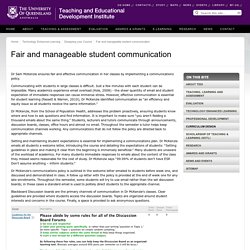
Communicating with students in large classes is difficult. Just a few minutes with each student can be impossible. Many academics experience email overload (Hole, 2008) - the sheer quantity of email and student expectation of immediate responses can cause immense stress. However, effective communication is essential for student learning (Fassett & Warren, 2010); Dr McKenzie identified communication as "an efficiency and equity issue so all students receive the same information.” Dr McKenzie, from the School of Population Health, addresses this problem proactively, ensuring students know where and how to ask questions and find information. Preparing Instructors for Quality Online Instruction.
Digital Literacy. Technology Selection. Blended Learning. Five-step Strategy for Student Success with Online Learning. Students that are enthusiastic about online learning cite numerous reasons for preferring the virtual format, yet it’s flexibility that is extolled most often – the ability to study and learn on ‘my time’. Ironically, it is this convenience factor that can cause some online students to procrastinate, or worse fail to engage in the learning process at all, which often leads to students dropping out or performing poorly. As discussed in previous posts, a key factor to student success in the online environment is self-direction, the capability and willingness to direct one’s own eduction. Technology, teaching and productivity: the need for theory. Critical Importance of Social Interaction in Online Courses. By Lynn Zimmerman Editor, Teacher Education Tom Preskett’s article, There’s Blended Learning and There’s Blended Learning!

, made two points in particular that started me thinking about group dynamics and how this plays out in face-to-face, hybrid, and online classes. First he said that in one model of hybrid courses “The course is explained, participants get to know each other, and bonds are formed.” Then later he commented: “Give a student in 2010 the alternative and F2F wins most of the time.”
Students' frustrations with a Web-based distance education course. Many advocates of computer-mediated distance education emphasize its positive aspects and understate the kind of work that it requires for students and faculty.
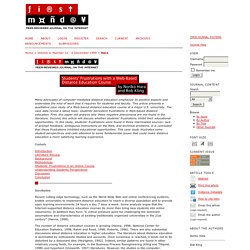
This article presents a qualitative case study of a Web-based distance education course at a major U.S. university. The case data reveal a taboo topic: students' persistent frustrations in Web-based distance education. First, this paper will analyze why these negative phenomena are not found in the literature. Second, this article will discuss whether students' frustrations inhibit their educational opportunities. In this study, students' frustrations were found in three interrelated sources: lack of prompt feedback, ambiguous instructions on the Web, and technical problems. Every Monday, the instructor of this course usually sent an e-mail message explaining the requirement for a particular module. Questions to Consider As You Prepare to Teach Your First Hybrid Course - TeachOnline. A hybrid course is much more than just an online course with a face-to-face class session thrown in for good measure.

It involves asking, “What is the best way for students to interact with course content, construct knowledge, engage in critical thinking and problem solving?” Purposeful decisions are made by the instructor as to what activities are best included in face-to-face class sessions, and which activities would work well in a virtual environment. The term hybrid, or blended course, signifies a new way of thinking about how to harness the power of technology to promote learning and identify the best strategies to help students master important course concepts. However, it is about more than just teaching an existing course in a new format. “Blended [hybrid] learning inherently is about rethinking and redesigning the teaching and learning relationship. Project Management for Instructional Designers. E-Guide:Undertaking a Needs Analysis for E-Learning. Brinthaput et al - How should i offer this course? JOLT Article. Milheim - Examining Student Needs in the Online Classroom through Maslow.
Karen L.

Milheim Contributing Faculty Center for Student Success Walden University Minneapolis, MN 55401 USA karen.milheim@waldenu.edu Introduction Distance education has rapidly evolved over the past decade. While courses have been delivered at a distance for more than a century (Valentine, 2002), as recently as the 1990s, traditional brick-and-mortar universities continued to engage students in paper-based correspondence courses, using course packets and the postal service as a primary means of delivering content and materials. The progression of distance education over the past decade can be attributed mostly to factors related to technology, including the proliferation of the Internet and other digital and networked learning tools. Classroom 2.0. LTTO Episodes - Wikis For Student Collaboration.
Design for Online Learning Using a Learner's Perspective Approach. For any individual who does instructional design, the challenge falls in the process and the nuances of the process.
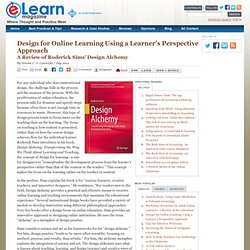
With the proliferation of online education, the process calls for dynamic and speedy steps because often there is not enough time or resources to waste. However, this type of design process tends to focus more on the teaching than on the learning. The focus on teaching is how content is presented, rather than on how the course design achieves flow for the individual learner. Roderick Sims introduces in his book, Design Alchemy: Transforming the Way We Think About Learning and Teaching, the concept of design for learning—a way for designers to "conceptualize the development process from the learner's perspective rather than that of the content or the teacher. " This concept makes the focus on the learning rather on the teacher or content. In the preface, Sims explains his book is for "curious learners, creative teachers, and innovative designers.
" The pedagogy. Simone C. PRIMER-on-Learning-Outcomes.pdf. Planning for Online Learning - Centre for Teaching and Learning. Teaching Methods > Online/Blended Key Shifts in Thinking for Online Learning When planning for teaching online there are several key shifts in thinking to transform a traditional classroom based course for online delivery.
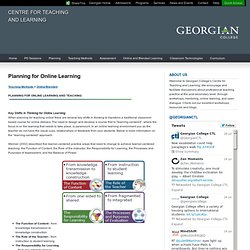
The need to design and develop a course that is “learning-centered”, where the focus is on the learning that needs to take place, is paramount. In an online learning environment you as the teacher do not have the visual cues, relationships or feedback from your students. Below is more information on the “learning-centered” approach. So you want to TEACH ONLINE? Modern Learning Strategies Workshop. Public online workshop runs: 5 May – 6 June 2014 About the Workshop The Networked Age demands a new set of learning skills and tools.
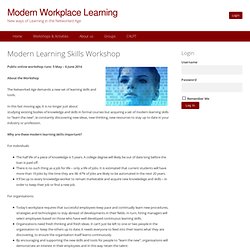
In this fast moving age, it is no longer just about studying existing bodies of knowledge and skills in formal courses but acquiring a set of modern learning skills to “learn the new”, ie constantly discovering new ideas, new thinking, new resources to stay up to date in your industry or profession. Why are these modern learning skills important? For individuals The half life of a piece of knowledge is 5 years. Planning for Online Learning - Centre for Teaching and Learning. Strategies for Online Teaching. Online teaching is increasingly common at many types of higher education institutions, ranging from hybrid courses that offer a combination of in-person and online instruction, to fully online experiences and distance learning.

The following resources provide guidelines for creating an online course, best practices for teaching online, and strategies for assessing the quality of online education. CRLT Occasional Paper #18: Online Teaching (Zhu, Dezure, & Payette, 2003) This paper explores key questions to consider when planning an online course and provides guidelines for effective instructional practices. UCD Planning Online and Blended Learning. UNSW Teaching Staff Gateway. The value of a flipped class is in the repurposing of class time into a workshop where students can enquire about lecture content, test their skills in applying knowledge, and interact with one another in hands-on activities. During class sessions, instructors function as coaches or advisors, encouraging students in individual enquiry and collaborative effort. The wide range of potential benefits of using a flipped classroom includes, but is not limited to, the fact that it can:
What is flipped classroom. Introduction to Cyber Security — The Open University.